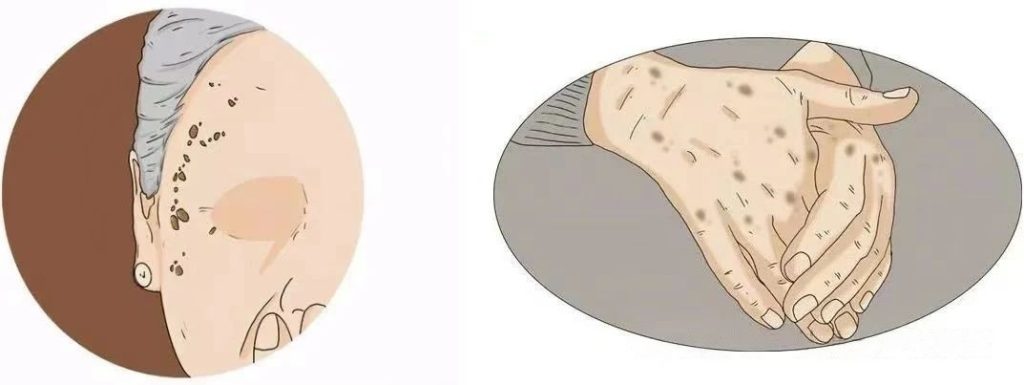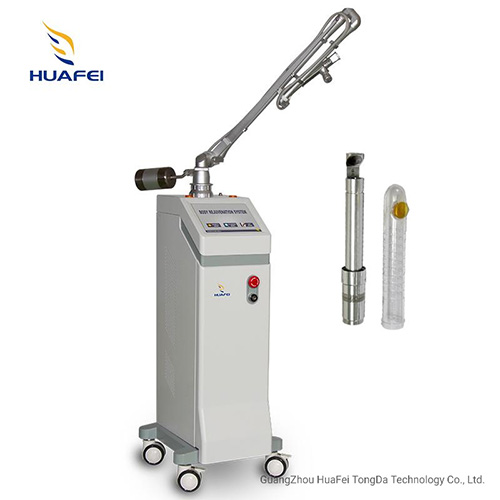Seborrheic keratosis (SK), also known as senile lentigo and senile pigment spots, is what we usually call “age spots”. It often appears on the head, face, neck, trunk and back of hands of adults over 40 years old.
Seborrheic keratosis generally does not cause malignant changes and does not endanger physical health, but it will affect the beauty of the face and cause patients to have negative emotions such as embarrassment, frustration, and inferiority. In severe cases, it can affect the patient’s social life.
In daily life, seborrheic keratosis gradually shows an early onset trend, and more and more middle-aged people are also troubled by age spots. They often think, how do I get rid of age spots naturally? How to treat age spots? Faced with a variety of treatment methods, is the most popular laser age spot removal effective?

Clinical manifestations of seborrheic keratosis (age spots).
Seborrheic keratosis has great variability in clinical presentation. Early lesions vary in size, depth, and color, generally presenting as well-defined flat, round or oval patches or macules.
They usually grow slowly in the early stages, but in the later stages, the lesions gradually increase in thickness over time and rarely resolve on their own.

How should seborrheic keratosis be treated?
There are many clinical treatments for seborrheic keratosis, including drug therapy, physical therapy and surgical treatment. Drug therapy has serious adverse reactions and a long course of treatment, and patients often cannot adhere to long-term treatment. Physical therapy also requires repeated treatments and is prone to cause problems such as pigmentation, blisters, and scar tissue formation. Surgery can cause complications such as scar formation and infection. Laser treatment is a good choice for the treatment of seborrheic keratosis.Laser for age spots can be effectively removed.
Comparison of treatments for seborrheic keratosis
| Treatment methods | Recommended degree | Strong and weak | Effect | Degree of risk |
| Q-switched ruby laser therapy | +95 | 强 | +95 | 3 |
| CO2 Laser Treatment | +95 | 强 | +95 | 3 |
| CO2 laser + Q-switched ruby laser treatment | +95 | 强 | +95 | 3 |
| Er:YAG laser treatment | +95 | 强 | +95 | 3 |
| Q-switched alexandrite laser treatment | +70 | 强 | +70 | 3 |
| Frequency-doubled Q-switched ND:YAG laser (532nm) treatment | +70 | 强 | +70 | 3 |
| Q-switched ND:YAG laser (1064nm) treatment | 0 | 强 | +5 | 3 |
| High power long pulse width laser therapy | 0 | 强 | +60 | 5 |
| Low power long pulse width laser therapy | +40 | 弱 | +20 | 2 |
| Intense Pulsed Light (Photon) Therapy | +50 | 弱 | +20 | 2 |
| removal by elimination | +30 | 强 | +95 | 4 |
| Cryotherapy | +20 | 强 | +20 | 4 |
| cautery with electrocautery | +30 | 强 | +60 | 5 |
| Surgical resection | +5 | 强 | +95 | 4 |
| Take tranexamic acid orally | +5 | 弱 | +5 | 0 |
| All-trans-Acid or hydroquinone for external use | +3 | 弱 | +5 | 3 |
| Combined treatment with all-trans-Acid and hydroquinone (Tokyo University method) | +50 | 弱 | +70 | 3 |
| Chemical Peel Treatment | +20 | 弱 | +10 | 1 |
For early seborrheic keratosis (only local pigmentation increase, not raised on the skin surface), various Q-switched lasers (such as Q-switched ruby laser, Alexandrite laser, YAG laser) or picosecond lasers can be selected for treatment. After treatment, local scabs may form, but no scars will be left. This is the best time to treat seborrheic keratosis, especially for facial seborrheic keratosis.
As the disease progresses, seborrheic keratosis may gradually thicken. Once it is raised on the skin surface, CO2 laser treatment is required. If seborrheic keratosis is patchy, Q532nm laser, Q755 alexandrite laser, or Q694nm ruby laser can be used for treatment.
In clinical practice, ultra-pulsed CO2 laser is currently a common method for treating seborrheic keratosis. It has a wavelength of 10600nm. The instantaneous high energy generated by ultra-pulsed CO2 laser produces a layer-by-layer carbonization and gasification effect on the tissue to remove the lesion. It has the characteristics of deep penetration depth and strong destructive power. It is especially suitable for skin lesions with deep lesions and large areas. However, ultra-pulsed CO2 laser causes great thermal damage and has high requirements for the surgeon. The depth of treatment must be accurately controlled to avoid problems such as scar formation.
There are also studies showing that Q-switched 532 nm laser combined with ultra-pulsed CO2 laser treatment of facial seborrheic keratosis patients has better results than ultra-pulsed CO2 laser treatment alone. This is because pulsed CO2 laser can generate instantaneous high energy, causing keratinocyte apoptosis, and can activate local immune status, inhibiting the progression of seborrheic keratosis. On the basis of this treatment, Q-switched 532 nm laser is used for point scanning treatment, which can penetrate the epidermis and accurately act on the pigment cells of the target tissue, promote the vaporization and fragmentation of pigment particles, and then be phagocytosed and excreted by macrophages without causing thermal damage to the tissues around the lesions.
Main reasons for declining satisfaction with age spot treatment.
The common reasons for the decline in patient satisfaction after laser treatment are mainly the appearance of complications such as superficial scars, pigmentation, erythema and edema, itching and pain, which may be related to the thermal damage caused by the high energy and frequency parameters used in the operation. This puts forward higher requirements on the energy selection and frequency parameters of the operator.

Summary of laser therapy for age spots.
- Although there are many treatments for seborrheic keratosis, laser treatment is a better choice.
- Ultrapulsed CO2 laser is currently a common method for the clinical treatment of seborrheic keratosis. Q-switched 532 nm laser combined with ultrapulsed CO2 laser is more effective in treating facial seborrheic keratosis.
- The decrease in patient satisfaction after laser treatment may be related to the thermal damage caused by the high energy and frequency parameters used in the operation.
Frequently asked questions about age spots answered.
Q: How effective is the get rid of age spots laser?
A: Among all the methods for treating age spots, laser removal of age spots is the most effective and recommended.
Q: Is removing age spots with laser treatment useful?
A: It is very effective. Laser treatment for removing age spots is currently the most popular, safe and effective treatment.
Q: What equipment does age spot removal laser include?
A: 10600nm fractional CO2 laser, IPL, Q-switched ND: YAG laser, picosecond laser, etc. are all laser equipment that can effectively remove age spots.
Q: Age spots vs freckles, what is the difference?
A: Age spots often appear in people over 40 years old, and are common in the middle to upper age groups, while freckles appear among teenagers. The causes of these two types of pigment spots are different, and they appear in different groups of people.
Q: Which laser is best for treating age spots?
A: The fractional CO2 laser 10600 nm long pulse laser device is the best machine for treating age spots. In clinical practice, if you need to consider the effectiveness of the treatment and high safety, you can consider this device.
Laser treatment equipment for age spots.
As a beauty machine manufacturer with 20 years of experience, we produce professional medical devices and equipment, and also have a dedicated beauty machine clinical training institution. In the treatment of age spots, also known as seborrheic keratosis, photoelectric laser treatment is the most effective and reliable. We also have extensive research and attempts on laser treatment of age spots.
For excellent machines for treating age spots, we first recommend fractional CO2 lasers for treating age spots, because this machine has a long pulse of 10600nm, which can penetrate into the dermis to remove and clean the pigment of age spots.
Secondly, q-switched lasers and picosecond laser are the main machines for removing pigments, and they can also be used. Since the skin layer of age spots is located in the dermis, we need a wavelength of 1064nm to treat age spots. The longer the wavelength, the deeper the skin layer can be reached.
Later, IPL machines and intense pulsed light devices can also treat age spots, but the energy and treatment time need to be controlled, otherwise it is easy to appear black and cause pigmentation.
If you need various beauty equipment to treat age spots, you can contact us at any time: professional medical equipment & equipment manufacturers.









